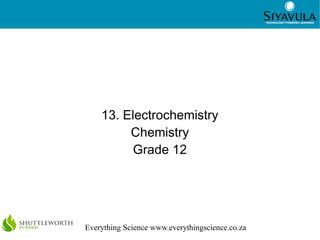
Electrochemistry
- 1. 1 Everything Science www.everythingscience.co.za 13. Electrochemistry Chemistry Grade 12
- 2. 2 Everything Science www.everythingscience.co.za Revision Oxidation is the loss of electrons and reduction is the gain of electrons. A redox reaction is one where there is always a change in the oxidation numbers of the elements that are involved in the reaction. It is possible to balance redox equations using the half-reactions that take place within the overall reaction.
- 3. 3 Everything Science www.everythingscience.co.za Electrochemical reactions: definitions An electrochemical reaction is one where either a chemical reaction produces an electric current, or where an electric current causes a chemical reaction to take place. An electrochemical cell is a device where electrochemical reactions take place. There are two types of electrochemical cell: galvanic and electrolytic. An electrode is an electrical conductor that connects the electrochemical species from its solution to the external electrical circuit of the cell. In electrochemical cells the two electrodes are referred to as the anode and the cathode. An electrolyte is a solution that contains free ions, and which therefore behaves as a conductor of charges (electrical conductor) in solution. A salt bridge is a material which contains electrolytic solution and acts as a connection between two half-cells (completes the circuit). It maintains electrical neutrality in and between the electrolytes in the half-cell compartments.
- 4. 4 Everything Science www.everythingscience.co.za Galvanic cells In a galvanic cell a chemical reaction produces a current in the external circuit. An example is the zinc-copper cell. In a galvanic cell each electrode is placed in a separate container in an electrolyte solution. The two electrolytes are connected by a salt bridge. We can use standard notation to represent a galvanic cell: X (s) | X+ (aq) || Y+ (aq) | Y (s)
- 5. 5 Everything Science www.everythingscience.co.za Electrolytic cell An electrolytic cell is an electrochemical cell that uses electricity to drive a non-spontaneous reaction. In an electrolytic cell, electrolysis occurs, which is a process of separating elements and compounds using an electric current. In an electrolytic cell both electrodes are placed in the same container in an electrolyte solution.
- 6. 6 Everything Science www.everythingscience.co.za Standard electrode potentials and cell EMF Different metals have different reaction potentials. The reduction potential of metals (in other words, their ability to ionise), is recorded in a table of standard electrode reduction potentials. The more negative the value, the greater the tendency of the metal to be oxidised. The more positive the value, the greater the tendency of the metal to be reduced. The values on the table of standard electrode potentials are measured relative to the standard hydrogen electrode. The EMF of an electrochemical cell can be calculated using one of the following equations: It is possible to predict whether a reaction is spontaneous or not, either by looking at the sign of the cell EMF or by comparing the electrode potentials of the two half-cells. A negative EMF indicates that the reaction will not occur spontaneously. E°(cell) = E° (reduction half-reaction) – E° (oxidation half-reaction) E°(cell) = E° (oxidising agent) – E° (reducing agent) E°(cell) = E° (cathode) – E° (anode)
- 7. 7 Everything Science www.everythingscience.co.za Applications Industrial applications of cells include electrolysis (the electrowinning of copper), in the chloralkali industry (mercury, diaphragm and membrane cells), as well as the extraction of metals from ores (e.g. aluminium from bauxite). Electrowinning of copper
- 8. 8 Everything Science www.everythingscience.co.za Applications – chloralkali The chlorine-alkali (chloralkali) industry is an important part of the chemical industry, which produces chlorine and sodium hydroxide through the electrolysis of the raw material brine. Three types of cell are used: mercury cell, diaphragm cell and membrane cell. Mercury cell This method only produces a fraction of the chlorine and sodium hydroxide that is used by industry. The chlorine produced is very pure, the cell requires a lot of electricity to run and produces toxic mercury waste.
- 9. 9 Everything Science www.everythingscience.co.za Diaphragm cell A porous diaphragm divides the electrolytic cell into an anode compartment and a cathode compartment. This cell uses less energy than the mercury cell but the products are not very pure. Membrane cell An ion-selective membrane divides the electrolytic cell into an anode compartment and a cathode compartment. This cell is the cheapest to operate and produces high purity products.
- 10. 10 Everything Science www.everythingscience.co.za For more practice see: everythingscience.co.za Shortcode: ESCRT
